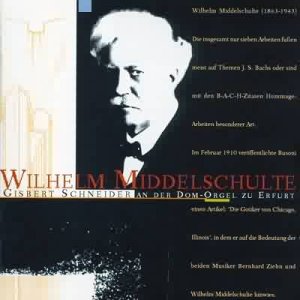Wilhelm Middelschulte was one of the two men Ferruccio
Busoni referred to as ‘the Gothics of Chicago’ (the other was the contrapuntal
theorist Bernhard Ziehn). After passing almost a century in near-complete
obscurity, Middelschulte appears at last to be emerging into the light.
In 2000 cpo released a CD of his organ music – the Toccata on ‘Ein'
fest Burg’, Contrapuntal Symphony, Two Studies on the
Chorale ‘Vater unser im Himmelreich’, Chromatic Fantasy and Fugue,
Perpetuum mobile and Chaconne – played by Jürgen Sonnentheil
(cpo 999 739-2). On 18 February 2003 the ever-venturesome Jane Parker-Smith
included his transcription of the Chaconne from the D minor Partita
(Bach-Busoni-Middelschulte: the list of names is growing) and his own
D minor Passacaglia in her concert in the Royal Festival Hall series
of organ recitals. Parker-Smith, indeed, is a Middelschulte enthusiast,
with his entire output in her collection. Perhaps his time is coming.
Sonnentheil was beaten to the draw, in fact, by Gisbert
Schneider, whose CD of Middelschulte organ music appeared from the German
label Cybele in 1999, although it is only now that it has come to my
attention. It is, in all fairness a magnificent CD, presenting magnificent
music. Middelschulte was a natural contrapuntal thinker, and his writing
suits the organ perfectly. The pieces presented here show him thinking
on a large scale, too: the Passacaglia, dark and severe, clocks in at
almost fourteen minutes, while the five-movement Concerto on a Theme
by Johann Sebastian Bach takes 35, and the Canonic Fantasy and
Fugue accounts for 25. The Concerto is a stunning demonstration
of Middelschulte’s musical imagination: the theme is that of the fugue
from the E minor Prelude and Fugue, BWV548, a chromatic wedge shape
which obviously cried out to Middelschulte with its latent developmental
possibilities. But the work is no Bachian imitation: Middelschulte writes
his own music, in rigorous and exciting counterpoint – it’s the organ
equivalent, if you like, of Busoni’s Fantasia contrappuntistica,
and one hears immediately why Middelschulte commanded Busoni’s respect.
The Concerto’s first movement contains a double fugue, the scherzo is
a canon at the octave, the Adagio a surprisingly brisk passacaglia,
the Intermezzo a fearsomely difficult pedal solo almost four minutes
in length, and the Finale a passacaglia with 39 variations, where I
don’t think he quite sustains the tension for all of its length, though
the music is never anything less than impressive. Likewise the Canonic
Fantasy and Fugue, where just now and again the onwards impetus
sometimes sags. What amazes here is Middelschulte’s contrapuntal virtuosity:
the Fantasy consists of no fewer than 43 canons on BACH, presented in
a bewildering variety of ways, and the fugue – presenting first the
BACH fugal subject from the nineteenth fugue of The Art of Fugue,
then the fugue theme from the D minor Toccata and Fugue, BWV565, the
‘Confiteor’ from the Mass in B minor, and finally the principal theme
of The Musical Offering – ends, God help me, by combining all
four! It’s a dazzling display of the contrapuntist’s art, and it’s thrilling
music, too, the closing bars blazing out in emphatic glory.
Gisbert Schneider gives heroic performances – this
must be appallingly difficult music to play, but there’s no hint of
strain in what he does; Parker-Smith perhaps played the Passacaglia
more sheerly excitingly, but it’s hardly fair to compare a recording
with a live performance. Friedhelm Onkelbach’s notes are helpful and
detailed, with six music examples to keep us au fait with what’s
going on in the music. The recorded sound I found a little distant on
first listening, but my ears soon adapted, and when the Erfurt Cathedral
organ is working on full power, it makes a magnificent noise.
Martin Anderson

![]() Gisbert Schneider (organ
of Erfurt Cathedral)
Gisbert Schneider (organ
of Erfurt Cathedral) ![]() CYBELE 050.201 [74.31]
CYBELE 050.201 [74.31]